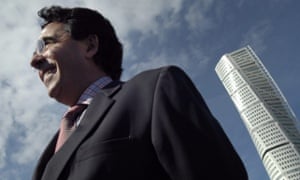
He’s one of the world’s most prominent architects, known for his complex aesthetic and intricate designs. But behind Spain’s Santiago Calatrava is a trail of frustrated clients, from a wine cellar near La Rioja whose leaky roof left it battling the elements, to the dazzling City of Arts and Sciences in Valencia whose final cost came in at four times the original price tag.
This week Calatrava defended his projects. “The reality is that throughout my career I’ve tackled projects in Spain that I’m proud of,” he told Spanish daily El Mundo.
The largest – and perhaps most controversial – collection of his work is in his home town of Valencia. The City of Arts and Sciences complex, which includes a concert hall, opera house and planetarium, saw its final cost swell to more than €1bn (£740m). Since the performance hall opened in 2005, authorities have complained of a leaky roof and chunks of the intricate mosaic flying off during high winds.
Anger over the project led one local politician to catalogue the project’s problems on a website, Calatravatelaclava, which translates loosely as “Calatrava bleeds you dry.” Last year, a court ordered the website to change its name and pay €30,000 in damages to the architect.
“I understand and accept criticisms of my work, provided they are done with professional criteria and arguments,” Calatrava told El Mundo. “Some have tried to use my work for politics, using inaccurate or out-of-context information that, repeated enough, becomes truth to some even though it is not.”
Opponents of the complex in Valencia said that Calatrava’s fee for the project was just shy of €100m for the project. Calatrava said on Monday that his job was made more difficult by those who question the fees he receives. “They criticise me for charging professional honorariums without even valuing the work that has been done.”
The interview was granted to El Mundo on the condition that the questions be first posed over email. A short phone conversation was then allowed to clear up any remaining questions. The interview process took more than a month.
Throughout his career Calatrava has designed dozens of structures – from the Turning Torso skyscraper in Malmö, Sweden, to the roof of the Athens Olympic Stadium. He is currently designing a six-mile-long bridge in Doha, Qatar, and was recently selected to design three bridges near Wuhan, China.
The architect is back in the headlines this week, as the designer of seven sculptures that line New York City’s Park Avenue. Just a few miles over, building continues on the Calatrava-designed Path commuter rail station at Ground Zero. The project is six years behind schedule and is expected to cost nearly $4bn (£2.6bn), twice what was originally budgeted.
For all his global success, the architect remains a controversial figure in Spain. In Bilbao, a glass-tiled footbridge came to be known as the wipeout bridge, with pedestrians slipping and falling every time it rained, while an airport in the outskirts of the city was built without an arrivals lounge, leaving airport authorities scrambling to build a glass-walled shelter so that visitors weren’t left in the cold. In La Rioja, northern Spain, Ysios winery launched a lawsuit over a leaky roof that compromised its ability to control humidity, while in Oviedo a court ordered Calatrava and his team to pay €2.9m after part of a conference centre collapsed during construction.
Calatrava said his work has been challenged by the economic crisis in Spain. “A decade ago, architecture was seen as a means to development. Big projects were perceived as an attraction, and many of them are,” he said, citing the City of Arts and Sciences in Valencia and its economic and social impact on the city. “Today with the current economic situation and the terrible crisis that many families are suffering through, what was once an investment in the future might be seen as a luxury. It’s understandable.”
He added: “I understand that people who are suffering don’t think it’s good that public powers spend money on costly infrastructure, but those decisions weren’t made in today’s context. And certainly they weren’t made by the architects.”
When asked about cost overruns, Calatrava pointed to the process behind designing a building. “There’s the sketch, a competition, and awarding of the contract. And from there, you hope you have a fair price. But it’s very difficult because there are a thousand variables that nobody can control.” For example, he said, building in Manhattan was more expensive because the freight costs to bring items to the island were very costly. “But we’re all trying to be more precise.”
At 63 years old, Calatrava said he hoped the best of his career was still to come. “Many of the architects I admire have given the best of themselves as they mature,” he said. “I’m hoping to do the same.”
Δεν υπάρχουν σχόλια:
Δημοσίευση σχολίου